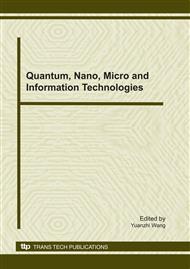[1]
Basu, C., Hirsh, H., and Cohen, W. (1998). Recommendation as Classification: Using Social and Content-based Information in Recommendation. In Recommender System Workshop '98. pp.11-15.
Google Scholar
[2]
Breese J, Hecherman D, Kadie C. Empirical analysis of predictive algorithms for collaborative filtering. In: Proceedings of the 14th Conference on Uncertainty in Artificial Intelligence (UAI'98). 1998. 43~52.
Google Scholar
[3]
Songjie Gong, A Collaborative Filtering Recommendation Algorithm Based on User Clustering and Item Clustering, Journal of Software, Volume 5, Number 7, July 2010, pp: 745-752.
DOI: 10.4304/jsw.5.7.745-752
Google Scholar
[4]
Songjie Gong, An Efficient Collaborative Recommendation Algorithm Based on Item Clustering, Lecture notes in electrical engineering, Volume 72, pp: 381-387.
DOI: 10.1007/978-3-642-14350-2_48
Google Scholar
[5]
BALABANOVIC, M. AND SHOHAM, Y. 1997. FAB: Content-based collaborative recommendation. Commun. ACM 40, 3 (Mar. ).
Google Scholar
[6]
M.G. Vozalis, K.G. Margaritis, Using SVD and demographic data for the enhancement of generalized Collaborative Filtering, Information Sciences 177 (2007) 3017–3037.
DOI: 10.1016/j.ins.2007.02.036
Google Scholar
[7]
GuangHua Cheng, SongJie Gong, An Efficient Collaborative Filtering Algorithm with Item Hierarchy, iita, vol. 3, pp.28-31, 2008 Second International Symposium on Intelligent Information Technology Application, (2008).
DOI: 10.1109/iita.2008.386
Google Scholar
[8]
SongJie Gong, HongWu Ye, XiaoYan Shi, A Collaborative Recommender Combining Item Rating Similarity and Item Attribute Similarity, isbim, vol. 2, pp.58-60, 2008 International Seminar on Business and Information Management, (2008).
DOI: 10.1109/isbim.2008.190
Google Scholar
[9]
Tae Hyup Roh, Kyong Joo Oh, Ingoo Han, The collaborative filtering recommendation based on SOM cluster-indexing CBR, Expert System with Application 25(2003) 413-423.
DOI: 10.1016/s0957-4174(03)00067-8
Google Scholar
[10]
ZHOU ShaoHua, FU Lue, LIANG BaoLiu, Clustering analysis of ancient celadon based on SOM neural network, Science in China Series E: Technological Sciences, 2008, 51(7): 999-1007.
DOI: 10.1007/s11431-008-0086-9
Google Scholar
[11]
WANG Ling, MU Zhi-Chun, GUO Hui, Combining Self-organizing Feature Map with Support Vector Regression Based on Expert System, ACTA AUTOMATICA SINICA, 2005, 31(4): 612-619.
Google Scholar
[12]
SongJie Gong, Hong-Wu Ye, XiaoMing Zhu, Item-based collaborative filtering recommendation using self-organizing map, ccdc2009, pp: 4029 – 4031.
DOI: 10.1109/ccdc.2009.5192713
Google Scholar
[13]
George Lekakos, George M. Giaglis, Improving the prediction accuracy of recommendation algorithms: Approaches anchored on human factors, Interacting with Computers 18 (2006) 410–431.
DOI: 10.1016/j.intcom.2005.11.004
Google Scholar
[14]
Gao Fengrong, Xing Chunxiao, Du Xiaoyong, Wang Shan, Personalized Service System Based on Hybrid Filtering for Digital Library, Tsinghua Science and Technology, Volume 12, Number 1, February 2007, 1-8.
DOI: 10.1016/s1007-0214(07)70001-9
Google Scholar
[15]
Songjie Gong, Employing User Attribute and Item Attribute to Enhance the Collaborative Filtering Recommendation, Journal of Software, Volume 4, Number 8, October 2009, pp: 883-890.
DOI: 10.4304/jsw.4.8.883-890
Google Scholar


